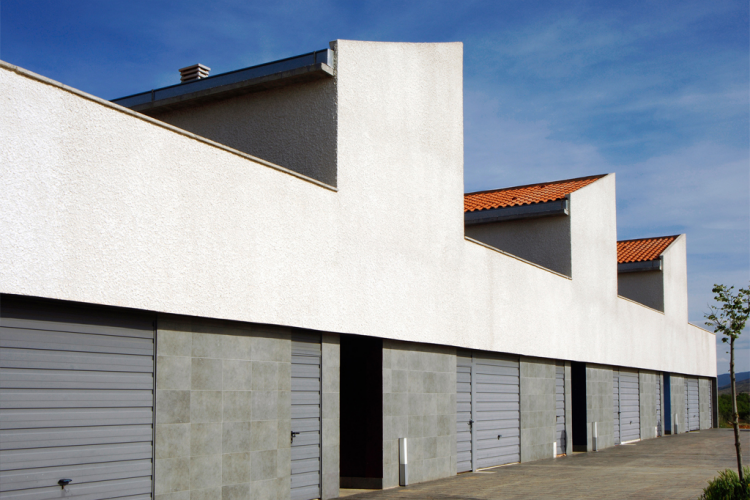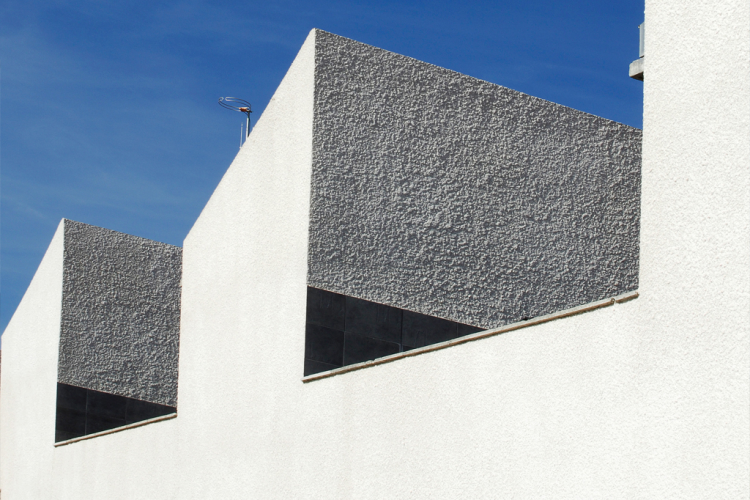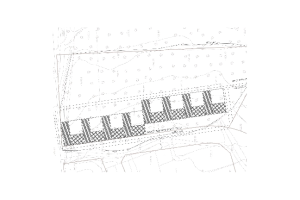BACKGROUND Action under this Institute by building 8 bioclimatic houses, garages, storage rooms and premises in the town of Tudelilla has achieved the goal of establishing new population in a small rural town of La Rioja, as well as facilitating access to housing protected with a bioclimatic architecture that gives the building an identity that reflects in the owners' benefit, with higher quality both technically and in the design of the project details. The homes have three bedrooms, with locally handcrafted, garage, balcony, porch and private garden access, and develop on two floors, with the living room, kitchen and toilet downstairs and bedrooms with bathroom on the first floor . In the design phase of these were taken into account bioclimatic factors such as the shape and orientation of the rooms, all south, for the most efficient use of solar energy. The passive solar gain is realized through rooms facing south, protected with a small visor summer. The core of the ladder allows cross ventilation with north and through the cover. The attached garage stays as locally handcrafted and made the effect of cap space, allowing for better isolation of living space. The ground floor is elevated thirty inches above ground level, leaving the garage and locally handcrafted with access to outdoor levels. RESOLUTION ADOPTED The program needs of the market and urban parameters collected in future municipal regulations define the boundaries of our intervention. Townhouses line parallel to the street layout is performed again. Half of the block is recessed to provide access to the last housing, bound thereto by the parcel. The proposal, however, is considered very urban to a small square corresponding to the private urbanization created. In both blocks created different units performing individual accesses through a small porch or vestibule are distinguished. Taking advantage of the privileged orientation, housing type is drawn on a substantially square plot, twelve meters facade fourteen background. The house, on two levels, situated in the north with all its south-facing garden with east where the olive is maintained, holes and annexes to housing, ground floor, west along the street. Thus the volume appears jagged north to south and from west to east, to facilitate sunshine throughout the house. The room, with the kitchen and the garden make up one space on ground floor. The staircase sets the vertical axis of communication. The bedrooms open to the south, with the main advantage of the terrace created on the annexes to housing, storage, garage and locally handcrafted, shaping the street front of redrawing. With the distribution of plants, an optimal program development and performance of the plot to adapt to social housing pursued. The homes reflect a clear hierarchical scheme with area day or publicly downstairs and sleeping area upstairs or private, although both areas facing south. Since the entry a clear spatial continuity is perceived by introducing natural light into the core of the house. In public facades, the staggered solution volumes, differentiates socket ground floor, the body intended upstairs apartment. The base contains the porch of access to housing, as well as tickets to supplementary local housing, coated all over it with artificial stone veneer, and its lacquered aluminum frames. A continuous line connecting the building to the ground, where clearly distinguished porches, shaded, access to housing is created. The upper floor, which conforms to the lineup, casts a shadow line that helps further frame the socket. The plaster projected clearly distinguishes the game projected volume between homes and their complementary local. The blind side elevations are projected. In the interior facades the traditional vertical modulation for holes is respected, but the projected artificial stone veneer is responsible for transmitting contemporaneity. All hollow housing open to the south and private garden, providing the ground or day area a light visor that protects in summer sunshine higher. The enclosure of the plot and the body of complementary housing, garage and locally handcrafted local, make up the image so entrenched traditional patio. The building stands on the ground, and allows a north-south cross ventilation. The material chosen for coating the walls is chosen for its durability and low maintenance. The cover of the housing area is to a water with ceramic tile flat, so as to allow the best sunshine in the neighboring garden. Complementary local are covered with a passable terrace, allowing control over housing and street. The north facade serves to support a canopy for rain water harvesting, which are used for watering the garden. Above cover only a fireplace, which includes vacuum cleaners and ventilation downspouts, topped so that harmonize with the set appears. Conceptual approaches The type of housing, materials and facades adapt to the place, looking for the best orientations and views, optimizing the use of solar, being environmentally friendly and integrated harmoniously into it. The aim was to provide the typologically traditional housing, especially in rural areas, but that never disappoints. Using the guidance, and integrating an ever coveted garden courtyard setting, the advantages offered by nature, with the shape of the building to exploit solar energy, providing heat in winter and cool in summer prey. The complementary use of the garden and small orchard even allows a self-sufficient housing. Garage and locally handcrafted meet the effect of isolating cap space even better housing. The ground floor is raised on the ground, taking advantage of the climate effect of soil and preventing water ingress. Maximize solar is removed, adapting and integrating environment harmoniously, without fanfare and scale. As many existing olive remains. They have primacy rationality and functionality, with large, versatile and open spaces, endowed with freedom of routes, facing south, and north-south easy ventilation. Durability, cost and maintenance are taken into account in the project as well as the need to use a contemporary language that simultaneously reinterpret traditional architecture. Aesthetic and compositional criteria The definition of a linear block of two-storey terraced houses adapts to the human scale, reducing the impact thereof with a stepped section, leaving a lower body with complimentary local housing and recessing the ground floor to strengthen their connection with the ground. The composition of the facades responds to its orientation. The innexistencia of holes where they are not needed is premeditated, and the interior layout of the house seeks to build the type of patio. A rhythm with a water covered to allow better sunlight is checked, and the game revoked plans that rest on the traditional socket, framing all accesses. Line shadows of horizontality and scale of the proposed facade. A permeable facade on the garden, with all their holes open at the same, protected by a small marquee for the summer period the day area located downstairs. The composition of hollow and solid is complemented by the choice of a material whose qualities, colors and textures ensure the beauty and harmony of the whole. Construction criteria The completion of the building responds to traditional construction methods, together with a simple and clear definition of the structural system and all its facilities. The materials are selected for their quality, economy, durability and low maintenance as well as traditional usage. Bioclimatic As the sun's main source of energy that affects the bioclimatic design, it is important to consider the trajectory that defines throughout the year for the best design and use of it. Hence, in this case insider south orientation, shape and orientation of the securing the heat in winter and cool in summer. The rather low winter sun enter through gaps in front, protecting the southern facade with a small ledge that allows to control the summer perpendicular rays. Some walls composed of two sheets of termoarcilla foreign and domestic double hollow brick with air chamber, bring the heat capacity and thermal inertia needed to get comfort in the house. The cover is made with ventilated air for better insulation and thermal behavior. The climatic effect of raising exploits ground floor on the ground, to improve insulation. The choice of joinery and glazing ensures the seal housing.
Modalidad Public housing
Uso
Fecha de inicio de obra 2003-06-01
Fecha del certificado final de obra 2013-06-01
- Alfonso A. Ibañez
- IRVISA
- Construcciones Lazaro Abad SL
- Pablo Martín Lázaro Abad
- Fernando Gómez Condón





